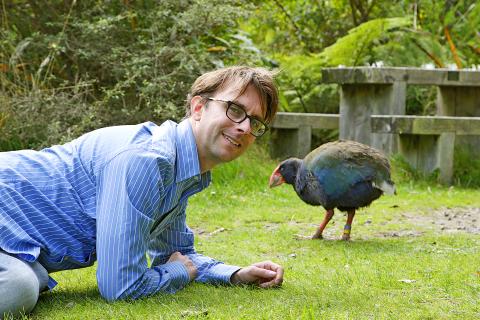New Zealand has set itself an environmental goal so ambitious it’s been compared to putting a man on the moon: ridding the entire nation of every last rat, opossum and stoat.
The idea is to give a second chance to the distinctive birds that once ruled the south Pacific nation. When New Zealand split away from the supercontinent Gondwanaland 85 million years ago, predatory mammals had not evolved. That allowed birds to thrive. Some gave up flight altogether to strut about the forest floor.
Then humans arrived, bringing predators with them. Rats stowed away on ships. Settlers introduced opossums for the fur trade and weasel-like stoats to control rabbits. The pests destroyed forest habitats and feasted on the birds and their eggs. More than 40 species of birds died out and many others remain threatened, including the iconic kiwi.

Photo: AP
Now people want to turn back the clock. Yet the plan sounds impossible. How do you kill millions of vermin across a country that is the size of the UK? How do you ensure a few furtive rats will not undo all the hard work by surviving and breeding?
Scientists are talking about the mission in military terms: choking off pests on peninsulas and then advancing the front lines from there; developing new traps and genetic weapons; and winning the hearts and minds of children and farmers alike.
Momentum began growing five years ago when the nation’s leading scientist, Paul Callaghan, delivered an impassioned speech.
When it comes to heritage, he said, England has its Stonehenge, China its Great Wall, France its Lascaux cave paintings.
What makes New Zealand unique, he asked? Its birds.
Callaghan was suffering from advanced cancer and could barely stand, but for more than an house he outlined his predator-free vision, saying how growing up he was inspired by efforts to reach the moon and how saving the birds could become New Zealand’s own Apollo program. He died a month later, but the vision grew.
Nine months ago, it became official government policy. Then-prime minister John Key announced a goal to wipe out the nuisance animals by 2050, calling it the “most ambitious conservation project attempted anywhere in the world.”
The goal has been embraced by many, although even its strongest supporters say it will require scientific breakthroughs. Some critics say the plan should also have targeted feral cats or worry mice numbers might explode if rats disappear. Others say the effort is underfunded and overly ambitious.
“It’s a fantasy science fiction,” said Wayne Linklater, a wildlife biologist at the Victoria University of Wellington. “And it really is seriously distracting us from some really big changes and improvements we can make in biodiversity and the environment now.”
The number of pests in New Zealand is many times larger than the human population of nearly 5 million. Opossum numbers in 2009 were estimated at 30 million. Scientists cannot hazard a guess at how many rats there are, because their numbers fluctuate wildly.
So far, the government has committed only a few tens of millions of dollars toward the project, which is estimated to cost billions. Officials say more money will come from local authorities and philanthropists.
Many are not waiting for that. Along a popular forest trail a 10-minute drive from the bustle of central Wellington, Jonathan Moulds takes breaks from his run to clamber up banks and check rat traps.
He is among 50 volunteer trappers who incorporate pest control into their regular workouts at the Polhill Reserve. Many became inspired three years ago after rare native birds that disappeared from the region a century ago began breeding there again.
Paul Ward, who leads the volunteer group, lists ways that birds have seeped into the culture, from the country’s music awards that are named after the boisterous tui to the nickname for a New Zealander: kiwi.
“It’s about looking after our identity as much as it is looking after the birds,” he said.
University of Auckland scientist James Russell has great hopes for the eradication plan — and he knows exactly how hard it can be to catch a single rat. During his doctoral research 15 years ago, Russell released monitored rats on small islands to see if they would take over.
The first rat he released, named Razza, evaded recapture for 18 weeks. It even swam to another island. The story inspired a local author to write a children’s book in which Razza defiantly repeats the line: “Can’t catch me.”
But Russell, heartened by the progress since then, says New Zealand leads the world in clearing vermin. Rangers have wiped out pests from more than 100 small islands, which are providing a breeding ground for rare birds. Yet making the much larger main islands pest-free remains an enormous leap.
Russell is helping lead an effort to find scientific breakthroughs, such as changing pest genes to make them die out, using biosensors to target individual pests over vast areas, and using powerful new lures that rely on the scent of sex rather than food.
Goodnature company in Wellington is coming up with its own innovations. It has developed traps that use pressurized carbon dioxide to reset themselves. Left alone, one trap can kill 24 rats in six months.
Other pest control methods have proved contentious, including use of the poison 1080, sodium fluoroacetate. Hunters say the toxin sometimes kills their dogsand animal advocacy groups say it is inhumane.
Conservation Minister Maggie Barry says a benefit of wiping out pests would be ending the use of such toxins.

BOMBARDMENT: Moscow sent more than 440 drones and 32 missiles, Volodymyr Zelenskiy said, in ‘one of the most terrifying strikes’ on the capital in recent months A nighttime Russian missile and drone bombardment of Ukraine killed at least 15 people and injured 116 while they slept in their homes, local officials said yesterday, with the main barrage centering on the capital, Kyiv. Kyiv City Military Administration head Tymur Tkachenko said 14 people were killed and 99 were injured as explosions echoed across the city for hours during the night. The bombardment demolished a nine-story residential building, destroying dozens of apartments. Emergency workers were at the scene to rescue people from under the rubble. Russia flung more than 440 drones and 32 missiles at Ukraine, Ukrainian President Volodymyr Zelenskiy

‘SHORTSIGHTED’: Using aid as leverage is punitive, would not be regarded well among Pacific Island nations and would further open the door for China, an academic said New Zealand has suspended millions of dollars in budget funding to the Cook Islands, it said yesterday, as the relationship between the two constitutionally linked countries continues to deteriorate amid the island group’s deepening ties with China. A spokesperson for New Zealand Minister of Foreign Affairs Winston Peters said in a statement that New Zealand early this month decided to suspend payment of NZ$18.2 million (US$11 million) in core sector support funding for this year and next year as it “relies on a high trust bilateral relationship.” New Zealand and Australia have become increasingly cautious about China’s growing presence in the Pacific

Indonesia’s Mount Lewotobi Laki-Laki yesterday erupted again with giant ash and smoke plumes after forcing evacuations of villages and flight cancelations, including to and from the resort island of Bali. Several eruptions sent ash up to 5km into the sky on Tuesday evening to yesterday afternoon. An eruption on Tuesday afternoon sent thick, gray clouds 10km into the sky that expanded into a mushroom-shaped ash cloud visible as much as 150km kilometers away. The eruption alert was raised on Tuesday to the highest level and the danger zone where people are recommended to leave was expanded to 8km from the crater. Officers also

ESPIONAGE: The British government’s decision on the proposed embassy hinges on the security of underground data cables, a former diplomat has said A US intervention over China’s proposed new embassy in London has thrown a potential resolution “up in the air,” campaigners have said, amid concerns over the site’s proximity to a sensitive hub of critical communication cables. The furor over a new “super-embassy” on the edge of London’s financial district was reignited last week when the White House said it was “deeply concerned” over potential Chinese access to “the sensitive communications of one of our closest allies.” The Dutch parliament has also raised concerns about Beijing’s ideal location of Royal Mint Court, on the edge of the City of London, which has so